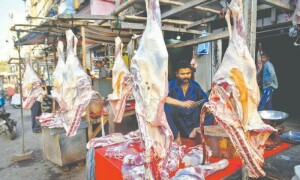Arid lands cover more than one-fifth of the earth’s surface and are found on every continent.
According to the World Meteorological Organisation, climate change and desertification are expected to lead to increasing levels of salinisation and desertification of agricultural lands.
These dry-lands are characterised by inhospitable temperatures, inaccessible terrain and scarcity of sweet water which makes inhabiting such areas difficult. Nonetheless, it is generally recognised that arid lands have a great potential for development.
According to the United Nations Office to Combat Desertification / United Nations Development Programme (UNCCD/ UNDP) these areas are home to about 50pc of the world’s livestock. About 13pc of the total world population (approximately 313m) live in arid zones with 92m alone residing in hyper-arid deserts.
Scarcity of freshwater is the major limiting factor. These areas largely depend on rainfall and/or groundwater for human needs, livestock consumption and sustaining scant agriculture.
However, recent scientific advancement and research have enhanced knowledge, providing a basis for humans to turn seemingly impossible situations into productive opportunities.
The desert aquaculture technology does not necessarily require significant investment and can be used for commercial, as well as small-scale affordable aquaculture initiatives
One option to utilise arid land and saline groundwater sources not fit for human consumption, or agriculture, is by cultivating organisms that can withstand the high content of salt prevalent there.
Seawater is being used to farm marine fish and plants all over the world. Similarly, the initiative of utilising desert saline or brackish water for fish farming was launched in 1963-1965 and tested experimentally, showing that it was possible to use such water to rear fish successfully.
The high mineral content in these waters, along with high ambient temperatures and solar radiation, in fact support high primary productivity; forming a suitable and favourable food-base for fish.
Since then scientists have been working on developing technologies suitable for fish farming and, as of today, many countries have developed successful models for fish production in brackish or saline water available underneath deserts and arid lands.
These systems, however, need good water management — which include saving and recycling — and the introduction of modern aquaculture technologies such as ‘recirculation aquaculture systems’.
These systems usually occupy a relatively small area and are extremely efficient, with water usage for fish production of up to 50 kg/m3.
The desert aquaculture technology does not necessarily require significant investment and can be used for commercial, as well as small-scale affordable aquaculture initiatives.
Apart from the farming of table fish, other commercially important and valuable organisms, tolerant to high salt concentrations and high temperatures, can also be produced in arid areas. Small brine shrimp, seaweed and the unicellular green algae are a few examples.
Currently, Australia farms supply over 60pc of the world’s natural b-carotene extracted from Dunaliella salina; which is mainly produced in large ponds of saline water extracted by tube-wells in South and Western Australia.
Innovative fish/vegetable co-culture systems are another option, which use the nutrient by-products of fish culture as a direct input for vegetable production; constantly recycling the same water in aquaponics systems.
Fish farming in desert and arid land is considered a fertile and lucrative enterprise these days.
Many countries have developed such fish farming thus making their lands arable and productive. US, South Africa, Mexico, Qatar, Saudi Arabia, Egypt and Israel are some examples.
Israel is one of the leading countries which have developed important innovations in arid and desert aquaculture by using saline ground water. It is exporting fish, vegetables and other agri-products produced in these desert systems. Such systems are more efficient in producing quality fish, vegetables and fruits, than conventional systems.
Climatically, except for the northern part, most of Pakistan is arid or semi-arid; however by virtue of a well-developed irrigation system, the problem is confined to deserts and hilly areas that do not receive irrigated water.
These areas include the Cholistan, Thal and Pothwar region in Punjab; Thar, Kachho and Kohistan in Sindh; the Kharan desert and hilly parts of Balochistan. Generally there, poverty is high and resources are scarce. The development and communication infrastructure is also very poor.
The current situation in the country’s arid areas demands immediate food security measures, particularly in Thar, Kachho and Kohistan in Sindh, where droughts have created acute food security issues.
There is an urgent need for utilising saline or brackish water resources available there to produce marine fish and shrimp, along with certain vegetables (in integrated fish-vegetable) in aquaponics systems. This will serve the purpose of securing food supply in areas where conventional agriculture is not an option.
The cultivation of fish with this new technology could create business opportunities, generate jobs and improve livelihoods in both deserts and arid lands.
The writer is a fisheries scientist at Auburn University, USA, researching the utilisation of saline groundwater for producing fish and vegetables.
Published in Dawn, Business & Finance weekly, November 14th, 2016














































